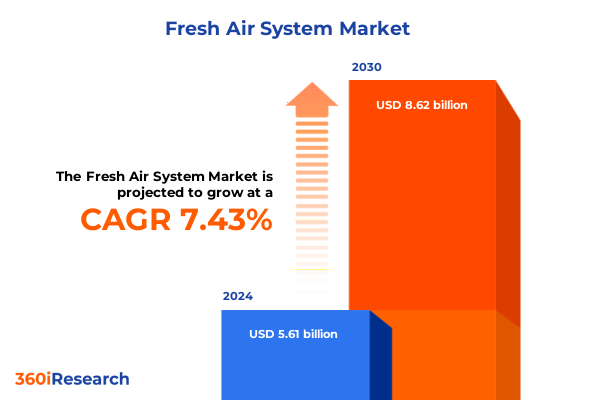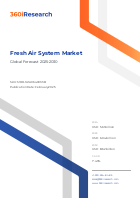The Fresh Air System Market size was estimated at USD 5.61 billion in 2024 and expected to reach USD 6.04 billion in 2025, at a CAGR 7.43% to reach USD 8.62 billion by 2030.

Introduction to the Fresh Air System Market Dynamics
The fresh air system market stands at a pivotal juncture, driven by escalating concerns over indoor and outdoor air quality, evolving regulatory landscapes, and accelerating technological innovation. As urban centers expand and industrial activity intensifies, stakeholders across commercial, industrial, and residential sectors are re-evaluating their air management strategies to safeguard health, comply with stringent regulations, and enhance operational efficiency. Against this backdrop, market participants face an imperative to understand emerging dynamics-from advancements in filtration materials to the integration of digital air quality monitoring-in order to capture new growth opportunities and mitigate potential risks.
In this executive summary, we explore the foundational trends shaping the fresh air system market, offering a concise yet comprehensive overview tailored for decision-makers and experts. By dissecting transformative shifts, regulatory impacts, segmentation insights, and regional nuances, we provide a roadmap for informed strategic planning. Throughout the report, we maintain a focus on actionable intelligence, synthesizing data-driven analysis with industry expertise to illuminate practical steps. Ultimately, our goal is to equip readers with a clear understanding of the current environment and to guide them toward sustainable, long-term value creation in the fresh air system ecosystem.
Transformative Shifts Reshaping the Fresh Air System Landscape
Over the past decade, the fresh air system landscape has undergone profound transformation, driven by four key forces: heightened environmental awareness, rapid advancements in filtration and purification technologies, digitalization, and shifting consumer expectations. Governments and regulatory bodies worldwide have introduced stricter emissions standards and indoor air quality mandates, compelling businesses to upgrade legacy systems.
Simultaneously, breakthroughs in nanomaterials and photocatalytic oxidation have elevated purification efficiency, enabling smaller, more energy-efficient units. Integrating sensors, IoT connectivity, and AI-enabled analytics, fresh air systems now offer real-time monitoring, predictive maintenance, and automated airflow optimization. These capabilities are increasingly critical for large‐scale commercial installations and industrial plants aiming to maintain uninterrupted production.
Consumer demand has also shifted dramatically, with residential users seeking smart, compact solutions that address allergens and airborne pathogens. As adoption spreads, economies of scale are driving down costs, further accelerating market penetration. In sum, the combination of regulatory pressure, technological innovation, digital transformation, and evolving end-user requirements has set the stage for a new era in air quality management.
Assessing the Cumulative Impact of United States Tariffs 2025
In 2025, the introduction of revised United States tariffs on imported components and finished fresh air systems will have far-reaching consequences. Tariff adjustments targeting key inputs-such as advanced filter media, ultraviolet lamps, and precision sensors-have increased the landed cost of several critical system elements. This shift has prompted domestic manufacturers to rethink supply chain configurations and source more inputs locally or from tariff-exempt regions.
Moreover, increased costs have intensified price sensitivity among end users, particularly in price-competitive segments like portable and residential units. Commercial and industrial buyers, while less price constrained, are demanding longer service intervals and enhanced energy performance to offset upfront premiums. As a result, many original equipment manufacturers are accelerating investments in cost-reduction strategies, including lean manufacturing, component redesign, and closer collaboration with domestic suppliers.
Looking ahead, the cumulative effect of these tariffs will likely reshape market share across geographic regions and between supplier categories. Companies that proactively adapt their sourcing strategies and innovate in system design will emerge stronger, while those reliant on imported inputs risk margin compression and potential erosion of competitive positioning.
Key Segmentation Insights Driving Market Differentiation
The fresh air system market reveals compelling differentiation when examined through multiple segmentation dimensions. Based on product type, demand patterns vary across air filters, HVAC systems, indoor and outdoor air purifiers, and portable systems, with advanced activated carbon filters, HEPA filters, hybrid filters, and ionizers each addressing unique performance requirements. End-user industries further refine this picture; commercial installations span office buildings, restaurants and clubs, and shopping malls, while the industrial arena encompasses chemical plants, manufacturing sites, and pharmaceutical facilities, and the residential segment includes both apartment buildings and individual houses.
Technology choices play a critical role in product positioning, as firms leverage activated carbon, HEPA, ionic filtration, photoelectrochemical oxidation-particularly advanced photocatalytic oxidation-and UV technology to meet specific contaminant challenges. Applications range widely from comprehensive air pollution control solutions to more targeted offerings for allergy and asthma relief, household use, pet owners, and smoke mitigation. Distribution channels likewise influence market access and consumer engagement, with offline retail through departmental, home improvement, and specialty stores coexisting alongside rapidly growing online platforms. Finally, customer type segmentation distinguishes corporate buyers, government and municipal entities, and individual consumers, each with distinct procurement cycles, quality expectations, and service requirements. Understanding these intersecting dimensions is essential for crafting tailored strategies and capturing untapped niches.
This comprehensive research report categorizes the Fresh Air System market into clearly defined segments, providing a detailed analysis of emerging trends and precise revenue forecasts to support strategic decision-making.
- Product Type
- End-User Industries
- Technology
- Application Areas
- Distribution Channels
- Customer Type
Key Regional Insights Highlighting Global Opportunities
Regional dynamics underscore divergent opportunities and challenges across the Americas, Europe, Middle East and Africa, and Asia-Pacific. In the Americas, sustained investments in facility upgrades and stringent EPA regulations are fueling demand for high-efficiency systems, with leading urban centers prioritizing retrofit projects. Across Europe, Middle East and Africa, regulatory harmonization around the EU’s air quality directives and growing awareness of air pollution’s health impacts are driving adoption, particularly in Germany, the UK, and the Gulf states, where infrastructure modernization programs are underway.
Meanwhile, Asia-Pacific presents a nuanced landscape: rapid urbanization in China and India is paired with ambitious national clean air campaigns, creating robust demand for both industrial and residential solutions; at the same time, Japan and South Korea focus on advanced technology integration and smart home ecosystems. Supply chain resilience has become a universal concern, prompting regional partnerships and nearshoring initiatives to mitigate geopolitical and logistical risks. By aligning product portfolios with regional regulatory frameworks and consumer priorities, market participants can unlock significant growth pockets across these diverse territories.
This comprehensive research report examines key regions that drive the evolution of the Fresh Air System market, offering deep insights into regional trends, growth factors, and industry developments that are influencing market performance.
- Americas
- Asia-Pacific
- Europe, Middle East & Africa
Key Companies Insights: Profiles of Industry Leaders
Analysis of leading players reveals a highly competitive environment where established brands and technology innovators vie for market leadership. Bosch Thermotechnology and Carrier Global Corporation, for instance, leverage expansive R&D networks to introduce next-generation HVAC systems with modular purification attachments. Daikin Industries, Ltd. and Emerson Electric Co. differentiate on energy efficiency and digital control suites, while Fujitsu General Limited and Hitachi Ltd. emphasize seamless integration with smart building platforms.
Honeywell International Inc. and Ingersoll Rand Inc. have ramped up investments in advanced filter media and centralized monitoring services, catering to large industrial customers. Johnson Controls International plc, Lennox International Inc., and LG Electronics Inc. focus on comprehensive product ecosystems spanning residential to commercial segments. Mitsubishi Electric Corporation, Nortek Global HVAC, and Panasonic Corporation capitalize on global manufacturing footprints to optimize cost structures and deliver localized solutions. Samsung Electronics Co., Ltd., Schneider Electric SE, and Siemens AG drive innovation in IoT-enabled air quality analytics. Finally, Toshiba Carrier Corporation, Trane Technologies plc, and United Technologies Corporation remain pivotal in setting performance benchmarks and shaping industry standards. This constellation of players collectively elevates market competition and accelerates technology adoption.
This comprehensive research report delivers an in-depth overview of the principal market players in the Fresh Air System market, evaluating their market share, strategic initiatives, and competitive positioning to illuminate the factors shaping the competitive landscape.
- Bosch Thermotechnology
- Carrier Global Corporation
- Daikin Industries, Ltd.
- Emerson Electric Co.
- Fujitsu General Limited
- Hitachi Ltd.
- Honeywell International Inc.
- Ingersoll Rand Inc.
- Johnson Controls International plc
- Lennox International Inc.
- LG Electronics Inc.
- Mitsubishi Electric Corporation
- Nortek Global HVAC
- Panasonic Corporation
- Samsung Electronics Co., Ltd.
- Schneider Electric SE
- Siemens AG
- Toshiba Carrier Corporation
- Trane Technologies plc
- United Technologies Corporation
Actionable Recommendations for Industry Leadership
To thrive in this dynamic environment, industry leaders must adopt a multifaceted approach. First, diversifying supply chains through a mix of domestic sourcing and strategic alliances will protect margins against tariff volatility and logistical disruptions. Second, investing in R&D partnerships to enhance filter media and purification technologies-particularly in photocatalytic and UV-driven systems-will strengthen product differentiation and command premium positioning.
Third, embracing digitalization by integrating sensors, AI analytics, and cloud-based control platforms will unlock new service revenue streams through predictive maintenance and performance benchmarking. Fourth, tailoring solutions to specific verticals-such as modular units for pharmaceutical cleanrooms or allergen-targeted purifiers for residential applications-will capture niche opportunities with higher loyalty and lower churn. Fifth, expanding omnichannel distribution networks by balancing offline expertise with online convenience will optimize reach and customer engagement.
By executing these recommendations in tandem, companies can build resilient operations, accelerate innovation adoption, and maintain a competitive edge across global markets.
Explore AI-driven insights for the Fresh Air System market with ResearchAI on our online platform, providing deeper, data-backed market analysis.
Ask ResearchAI anything
World's First Innovative Al for Market Research
Conclusion: Navigating the Path Forward
In conclusion, the fresh air system market is poised for sustained transformation as regulatory pressures, technological breakthroughs, and shifting end-user priorities converge. Companies that proactively adapt to tariff impacts by reconfiguring supply chains and investing in domestic partnerships will secure cost advantages. Meanwhile, those that accelerate innovation in advanced filtration and digital monitoring stand to redefine performance standards and deepen customer relationships.
Regional strategies must remain agile, aligning product offerings with local regulatory agendas and consumer expectations across the Americas, Europe, Middle East and Africa, and Asia-Pacific. Finally, forging collaborations among technology providers, system integrators, and end-users will catalyze ecosystem value and drive scalable solutions. By embracing these imperatives, market participants can chart a path toward resilient growth and sustained leadership in an increasingly complex and competitive landscape.
This section provides a structured overview of the report, outlining key chapters and topics covered for easy reference in our Fresh Air System market comprehensive research report.
- Preface
- Research Methodology
- Executive Summary
- Market Overview
- Market Dynamics
- Market Insights
- Cumulative Impact of United States Tariffs 2025
- Fresh Air System Market, by Product Type
- Fresh Air System Market, by End-User Industries
- Fresh Air System Market, by Technology
- Fresh Air System Market, by Application Areas
- Fresh Air System Market, by Distribution Channels
- Fresh Air System Market, by Customer Type
- Americas Fresh Air System Market
- Asia-Pacific Fresh Air System Market
- Europe, Middle East & Africa Fresh Air System Market
- Competitive Landscape
- ResearchAI
- ResearchStatistics
- ResearchContacts
- ResearchArticles
- Appendix
- List of Figures [Total: 28]
- List of Tables [Total: 554 ]
Call to Action: Secure Your In-Depth Market Report Today
To gain a comprehensive understanding of these trends and to access in-depth market analysis, please contact Ketan Rohom (Associate Director, Sales & Marketing at 360iResearch). Secure the full report today and equip your organization with the insights needed to make confident, strategic decisions in the fresh air system market.

- How big is the Fresh Air System Market?
- What is the Fresh Air System Market growth?
- When do I get the report?
- In what format does this report get delivered to me?
- How long has 360iResearch been around?
- What if I have a question about your reports?
- Can I share this report with my team?
- Can I use your research in my presentation?




